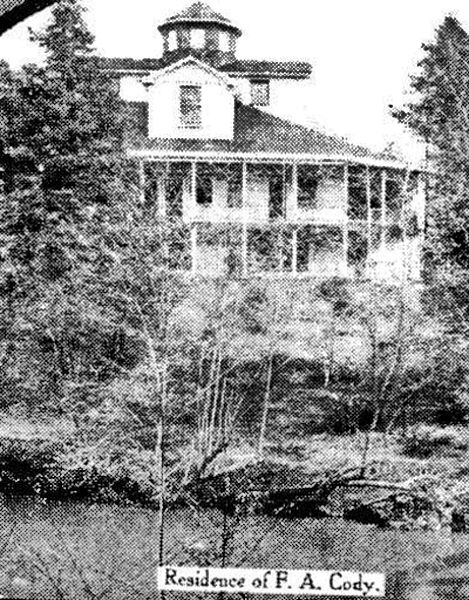His famous cousin would probably have arrived in Ben Lomond on a water-smooth silvery stallion, but Frederick A. Cody rode in on the train. Admittedly, Buffalo Bill was a distant cousin, but F. A. Cody probably profited from the connection. A traveling sales specialist for an electric light company, he provided systems for small cities, and also promoted stock companies to fund them. During an extended stay in Mexico, Cody carefully built up his capital nest egg, waiting for an opportunity like that offered by D. W. Johnston, who was ready to unload his property in Ben Lomond.
The tipping point may have been the fire in May, 1901 that destroyed the Jones and Silvey lumber mill along with the electrical machinery Johnston had imported from the East to illuminate the Hotel Ben Lomond. It was obvious that the town not only lacked a fire department, but that the water system inherited from Pierce’s Pacific Mills, was inadequate. Ben Lomond’s population had grown from a handful of families to an estimated 600 full-time residents and over a thousand summer visitors, but little had been done to upgrade its water supply.
Cody proved to be a tough negotiator, making it clear that the hotel wasn’t worth as much to him as the Ben Lomond Water Works. Finally, in November, 1901, a deal was struck and, for about $20,000, some of it in the form of a ranch in Fresno, the newcomer received title to the utility, hotel, and five undeveloped tracts of land on the Mill street side of the railroad tracks.
Soon after New Year’s Day, a force of hired hands, led by Cody and his adult son, a licensed plumber, went to work. “An extra large new tank,” noted the Mountain Echo, “is being put at the source of the water supply on Marshall Creek — which comes gurgling down the mountain side.” Nearly a mile of six-inch pipe was laid from one end of town to the other and nine hydrants installed along Mill Street.
One of the entrepreneur’s goals was to provide gainful employment for his son, Lynn, and his daughter Edna, who was recently enrolled in business school. When the latest lessee of the Hotel Ben Lomond left in August, “Cody and Son,” took over, promising to keep it open through the fall. The new partnership also advertised building lots for sale in San Francisco and Oakland papers. Before the next summer season, however, father and son were out of the hotel business.
The wooden town of Ben Lomond had been built by carpenters. The constant threat of fire preyed on local minds. In the fall of 1903, the young ladies of the town took charge of the problem. The public hall attached to the town’s general store hosted a Halloween costume ball. The volunteer organizers decorated the space with evergreen boughs and bunting and hired a dance band.
It was a long-remembered affair. Over thirty years later, the Santa Cruz News was told that: “The first dance was a very great success and with the money raised, the committee which had been appointed to purchase fire apparatus ordered a two-wheeled red cart striped with gold. The cart was equipped with a drag line and a handy jockey box, containing a monkey wrench and two spanners.”
When the cart arrived in the spring of 1904, the committee learned that it had overlooked some fine print. That June, another “Fireman’s Ball” filled Sterling’s Hall. Miss Edna Cody had charge of the entertainment and, although she finished second in the “most popular young lady” poll, and her business acumen was evident. An estimated three to four hundred dancers brought in the funds needed to purchase hose for the cart’s reel.
Gazing with pride on their new equipment, the fire committee realized that they needed a place to shelter it. F. A. Cody promptly stepped up, donating a lot on the site of the old mill pond. “The fire department boys,” reported the Mountain Echo at the end of July, “have just completed a substantial hose house in the center of town.” In front of the building a big steel triangle with a striker was hung.
The wave of civic enthusiasm generated a new plan. The San Francisco Call heard that: “Ben Lomond is to have a big amusement park.” Cody and other owners of riverside properties talked about donating land for a casino, restaurant, and dancing pavilion. “An immense dam,” the paper predicted, “is to be built across the river, the waters to be used for generating light and for boating and bathing.”
To Be Continued.
Randall C. Brown is a local historian and is a member of the SLVWD













